Ethosomes and Transethosomes for Mangiferin Transdermal Delivery
Abstract
1. Introduction
2. Materials and Methods
2.1. Materials
2.2. Mangiferin Solubility Evaluation
2.3. Production of Ethosomes and Transethosomes
2.4. Photon Correlation Spectroscopy (PCS)
2.5. Cell Culture and Cytotoxicity Study
2.6. Mangiferin Content of Ethosomes and Transethosomes
2.7. Antioxidant Activity (2,2-Diphenyl-1-Picrylhydrazyl Assay)
2.8. Cryo-Transmission Electron Microscopy (Cryo-TEM)
2.9. In Vitro Diffusion Experiments
2.10. HPLC Analysis
2.11. Cigarette Smoke (CS) Exposure
2.12. RNA Extraction and Quantitative Real-Time PCR
2.13. Immunocytochemistry
2.14. Transmission Electron Microscopy
2.15. Statistical Analysis
3. Results and Discussion
3.1. Preparation and Characterization of Ethosomes and Transethosomes
3.2. Preparation and Characterization of Ethosomes and Transethosomes Loaded with MG
3.3. Cytotoxicity Evaluation
3.4. Morphological Characterization
3.5. MG Diffusion Kinetics
3.6. Antioxidant and Anti-Inflammatory Effects of MG on HaCaT Cells Exposed to CS
3.7. E and ET Uptake in Keratinocytes Detected by TEM
4. Conclusions
Supplementary Materials
Author Contributions
Funding
Institutional Review Board Statement
Informed Consent Statement
Data Availability Statement
Acknowledgments
Conflicts of Interest
References
- Matkowski, A.; Kus, P.; Goralska, E.; Wozniak, D. Mangiferin—A Bioactive Xanthonoid, Not Only from Mango and Not Just Antioxidant. MRMC 2013, 13, 439–455. [Google Scholar] [CrossRef]
- Jyotshna; Khare, P.; Shanker, K. Mangiferin: A Review of Sources and Interventions for Biological Activities: Mangiferin. BioFactors 2016, 42, 504–514. [Google Scholar] [CrossRef]
- Khurana, R.K.; Kaur, R.; Lohan, S.; Singh, K.K.; Singh, B. Mangiferin: A Promising Anticancer Bioactive. Pharm. Pat. Anal. 2016, 5, 169–181. [Google Scholar] [CrossRef] [PubMed]
- Jiang, T.; Han, F.; Gao, G.; Liu, M. Mangiferin Exert Cardioprotective and Anti-Apoptotic Effects in Heart Failure Induced Rats. Life Sci. 2020, 249, 117476. [Google Scholar] [CrossRef] [PubMed]
- Du, S.; Liu, H.; Lei, T.; Xie, X.; Wang, H.; He, X.; Tong, R.; Wang, Y. Mangiferin: An Effective Therapeutic Agent against Several Disorders (Review). Mol. Med. Rep. 2018. [Google Scholar] [CrossRef]
- Vyas, A.; Syeda, K.; Ahmad, A.; Padhye, S.; Sarkar, F.H. Perspectives on Medicinal Properties of Mangiferin. MRMC 2012, 12, 412–425. [Google Scholar] [CrossRef]
- Selles, A.J.N.; Daglia, M.; Rastrelli, L. The Potential Role of Mangiferin in Cancer Treatment through Its Immunomodulatory, Anti-Angiogenic, Apoptopic, and Gene Regulatory Effects. BioFactors 2016, 42, 475–491. [Google Scholar] [CrossRef] [PubMed]
- Zhao, Y.; Wang, W.; Wu, X.; Ma, X.; Qu, R.; Chen, X.; Liu, C.; Liu, Y.; Wang, X.; Yan, P.; et al. Mangiferin Antagonizes TNF-α-Mediated Inflammatory Reaction and Protects against Dermatitis in a Mice Model. Int. Immunopharmacol. 2017, 45, 174–179. [Google Scholar] [CrossRef]
- Telang, M.; Dhulap, S.; Mandhare, A.; Hirwani, R. Therapeutic and Cosmetic Applications of Mangiferin: A Patent Review. Expert Opin. Ther. Pat. 2013, 23, 1561–1580. [Google Scholar] [CrossRef]
- Abdulbaqi, I.M.; Darwis, Y.; Khan, N.A.K.; Assi, R.A.; Khan, A.A. Ethosomal Nanocarriers: The Impact of Constituents and Formulation Techniques on Ethosomal Properties, in Vivo Studies, and Clinical Trials. Int. J. Nanomed. 2016, 11, 2279–2304. [Google Scholar] [CrossRef] [PubMed]
- Natsheh, H.; Vettorato, E.; Touitou, E. Ethosomes for Dermal Administration of Natural Active Molecules. CPD 2019, 25, 2338–2348. [Google Scholar] [CrossRef]
- Mahmood, S.; Mandal, U.K.; Chatterjee, B. Transdermal Delivery of Raloxifene HCl via Ethosomal System: Formulation, Advanced Characterizations and Pharmacokinetic Evaluation. Int. J. Pharm. 2018, 542, 36–46. [Google Scholar] [CrossRef]
- Shen, L.-N.; Zhang, Y.-T.; Wang, Q.; Xu, L.; Feng, N.-P. Enhanced in Vitro and in Vivo Skin Deposition of Apigenin Delivered Using Ethosomes. Int. J. Pharm. 2014, 460, 280–288. [Google Scholar] [CrossRef]
- Kwak, S.; Brief, E.; Langlais, D.; Kitson, N.; Lafleur, M.; Thewalt, J. Ethanol Perturbs Lipid Organization in Models of Stratum Corneum Membranes: An Investigation Combining Differential Scanning Calorimetry, Infrared and 2H NMR Spectroscopy. Biochim. Biophys. Acta 2012, 1818, 1410–1419. [Google Scholar] [CrossRef]
- Ma, M.; Wang, J.; Guo, F.; Lei, M.; Tan, F.; Li, N. Development of Nanovesicular Systems for Dermal Imiquimod Delivery: Physicochemical Characterization and in Vitro/in Vivo Evaluation. J. Mater. Sci. Mater. Med. 2015, 26, 191. [Google Scholar] [CrossRef] [PubMed]
- Song, C.K.; Balakrishnan, P.; Shim, C.-K.; Chung, S.-J.; Chong, S.; Kim, D.-D. A Novel Vesicular Carrier, Transethosome, for Enhanced Skin Delivery of Voriconazole: Characterization and in Vitro/in Vivo Evaluation. Colloids Surf. B Biointerfaces 2012, 92, 299–304. [Google Scholar] [CrossRef]
- Song, H.; Wen, J.; Li, H.; Meng, Y.; Zhang, Y.; Zhang, N.; Zheng, W. Enhanced Transdermal Permeability and Drug Deposition of Rheumatoid Arthritis via Sinomenine Hydrochloride-Loaded Antioxidant Surface Transethosome. Int. J. Nanomed. 2019, 14, 3177–3188. [Google Scholar] [CrossRef]
- Ascenso, A.; Raposo, S.; Batista, C.; Cardoso, P.; Mendes, T.; Praça, F.G.; Bentley, M.V.L.B.; Simões, S. Development, Characterization, and Skin Delivery Studies of Related Ultradeformable Vesicles: Transfersomes, Ethosomes, and Transethosomes. Int. J. Nanomed. 2015, 10, 5837–5851. [Google Scholar] [CrossRef] [PubMed]
- Soeur, J.; Belaïdi, J.-P.; Chollet, C.; Denat, L.; Dimitrov, A.; Jones, C.; Perez, P.; Zanini, M.; Zobiri, O.; Mezzache, S.; et al. Photo-Pollution Stress in Skin: Traces of Pollutants (PAH and Particulate Matter) Impair Redox Homeostasis in Keratinocytes Exposed to UVA1. J. Dermatol. Sci. 2017, 86, 162–169. [Google Scholar] [CrossRef] [PubMed]
- Kim, K.E.; Cho, D.; Park, H.J. Air Pollution and Skin Diseases: Adverse Effects of Airborne Particulate Matter on Various Skin Diseases. Life Sci. 2016, 152, 126–134. [Google Scholar] [CrossRef]
- Prieux, R.; Eeman, M.; Rothen-Rutishauser, B.; Valacchi, G. Mimicking Cigarette Smoke Exposure to Assess Cutaneous Toxicity. Toxicol. In Vitro 2020, 62, 104664. [Google Scholar] [CrossRef]
- Morita, A.; Torii, K.; Maeda, A.; Yamaguchi, Y. Molecular Basis of Tobacco Smoke-Induced Premature Skin Aging. J. Investig. Dermatol. Symp. Proc. 2009, 14, 53–55. [Google Scholar] [CrossRef] [PubMed]
- Guttman-Yassky, E.; Krueger, J.G.; Lebwohl, M.G. Systemic Immune Mechanisms in Atopic Dermatitis and Psoriasis with Implications for Treatment. Exp. Dermatol. 2018, 27, 409–417. [Google Scholar] [CrossRef]
- Freiman, A.; Bird, G.; Metelitsa, A.I.; Barankin, B.; Lauzon, G.J. Cutaneous Effects of Smoking. J. Cutan. Med. Surg. 2004, 8, 415–423. [Google Scholar] [CrossRef]
- Pleguezuelos-Villa, M.; Diez-Sales, O.; Manca, M.L.; Manconi, M.; Sauri, A.R.; Escribano-Ferrer, E.; Nácher, A. Mangiferin Glycethosomes as a New Potential Adjuvant for the Treatment of Psoriasis. Int. J. Pharm. 2020, 573, 118844. [Google Scholar] [CrossRef]
- Hallan, S.S.; Sguizzato, M.; Mariani, P.; Cortesi, R.; Huang, N.; Simelière, F.; Marchetti, N.; Drechsler, M.; Ruzgas, T.; Esposito, E. Design and Characterization of Ethosomes for Transdermal Delivery of Caffeic Acid. Pharmaceutics 2020, 12, 740. [Google Scholar] [CrossRef]
- Pecora, R. Dynamic Light Scattering Measurement of Nanometer Particles in Liquids. J. Nanopart. Res. 2000, 2, 123–131. [Google Scholar] [CrossRef]
- Sze, A.; Erickson, D.; Ren, L.; Li, D. Zeta-Potential Measurement Using the Smoluchowski Equation and the Slope of the Current-Time Relationship in Electroosmotic Flow. J. Colloid Interface Sci. 2003, 261, 402–410. [Google Scholar] [CrossRef]
- Sguizzato, M.; Valacchi, G.; Pecorelli, A.; Boldrini, P.; Simelière, F.; Huang, N.; Cortesi, R.; Esposito, E. Gallic Acid Loaded Poloxamer Gel as New Adjuvant Strategy for Melanoma: A Preliminary Study. Colloids Surf. B Biointerfaces 2020, 185, 110613. [Google Scholar] [CrossRef] [PubMed]
- Sguizzato, M.; Mariani, P.; Spinozzi, F.; Benedusi, M.; Cervellati, F.; Cortesi, R.; Drechsler, M.; Prieux, R.; Valacchi, G.; Esposito, E. Ethosomes for Coenzyme Q10 Cutaneous Administration: From Design to 3D Skin Tissue Evaluation. Antioxidants 2020, 9, 485. [Google Scholar] [CrossRef] [PubMed]
- Blois, M.S. Antioxidant Determinations by the Use of a Stable Free Radical. Nature 1958, 181, 1199–1200. [Google Scholar] [CrossRef]
- Esposito, E.; Ravani, L.; Mariani, P.; Huang, N.; Boldrini, P.; Drechsler, M.; Valacchi, G.; Cortesi, R.; Puglia, C. Effect of Nanostructured Lipid Vehicles on Percutaneous Absorption of Curcumin. Eur. J. Pharm. Biopharm. 2014, 86, 121–132. [Google Scholar] [CrossRef] [PubMed]
- Hallan, S.S.; Sguizzato, M.; Drechsler, M.; Mariani, P.; Montesi, L.; Cortesi, R.; Björklund, S.; Ruzgas, T.; Esposito, E. The Potential of Caffeic Acid Lipid Nanoparticulate Systems for Skin Application: In Vitro Assays to Assess Delivery and Antioxidant Effect. Nanomaterials 2021, 11, 171. [Google Scholar] [CrossRef] [PubMed]
- FDA Guidance for Industry: SUPAC-SS: Nonsterile Semisolid Dosage Forms; Scale-Up and Post-Approval Changes: Chemistry, Manufacturing and Controls; In-Vitro Release Testing and In Vivo Bioequivalence Documentation—ECA Academy. Available online: https://www.gmp-compliance.org/guidelines/gmp-guideline/fda-guidance-for-industry-supac-ss-nonsterile-semisolid-dosage-forms-scale-up-and-post-approval-changes-chemistry-manufacturing- (accessed on 23 November 2019).
- Muresan, X.M.; Sticozzi, C.; Belmonte, G.; Savelli, V.; Evelson, P.; Valacchi, G. Modulation of Cutaneous Scavenger Receptor B1 Levels by Exogenous Stressors Impairs “In Vitro” Wound Closure. Mech. Ageing Dev. 2018, 172, 78–85. [Google Scholar] [CrossRef]
- Valacchi, G.; Pecorelli, A.; Mencarelli, M.; Carbotti, P.; Fortino, V.; Muscettola, M.; Maioli, E. Rottlerin: A Multifaced Regulator of Keratinocyte Cell Cycle. Exp. Dermatol. 2009, 18, 516–521. [Google Scholar] [CrossRef]
- Toni, L.S.; Garcia, A.M.; Jeffrey, D.A.; Jiang, X.; Stauffer, B.L.; Miyamoto, S.D.; Sucharov, C.C. Optimization of Phenol-Chloroform RNA Extraction. MethodsX 2018, 5, 599–608. [Google Scholar] [CrossRef] [PubMed]
- Ferrara, F.; Pambianchi, E.; Pecorelli, A.; Woodby, B.; Messano, N.; Therrien, J.-P.; Lila, M.A.; Valacchi, G. Redox Regulation of Cutaneous Inflammasome by Ozone Exposure. Free Radic. Biol. Med. 2020, 152, 561–570. [Google Scholar] [CrossRef]
- Canella, R.; Benedusi, M.; Martini, M.; Cervellati, F.; Cavicchio, C.; Valacchi, G. Role of Nrf2 in Preventing Oxidative Stress Induced Chloride Current Alteration in Human Lung Cells. J. Cell. Physiol. 2018, 233, 6018–6027. [Google Scholar] [CrossRef]
- Costanzo, M.; Malatesta, M. Embedding Cell Monolayers to Investigate Nanoparticle-Plasmalemma Interactions at Transmission Electron Microscopy. Eur. J. Histochem. 2019, 63. [Google Scholar] [CrossRef]
- Woodford, R.; Barry, B.W. Penetration Enhancers and the Percutaneous Absorption of Drugs: An Update. J. Toxicol. Cutan. Ocul. Toxicol. 1986, 5, 167–177. [Google Scholar] [CrossRef]
- Lachenmeier, D.W. Safety Evaluation of Topical Applications of Ethanol on the Skin and inside the Oral Cavity. J. Occup. Med. Toxicol. 2008, 3, 26. [Google Scholar] [CrossRef]
- Kirjavainen, M.; Mönkkönen, J.; Saukkosaari, M.; Valjakka-Koskela, R.; Kiesvaara, J.; Urtti, A. Phospholipids Affect Stratum Corneum Lipid Bilayer Fluidity and Drug Partitioning into the Bilayers. J. Control. Release 1999, 58, 207–214. [Google Scholar] [CrossRef]
- Limsuwan, T.; Boonme, P.; Khongkow, P.; Amnuaikit, T. Ethosomes of Phenylethyl Resorcinol as Vesicular Delivery System for Skin Lightening Applications. BioMed Res. Int. 2017, 2017, e8310979. [Google Scholar] [CrossRef]
- El Zaafarany, G.M.; Awad, G.A.S.; Holayel, S.M.; Mortada, N.D. Role of Edge Activators and Surface Charge in Developing Ultradeformable Vesicles with Enhanced Skin Delivery. Int. J. Pharm. 2010, 397, 164–172. [Google Scholar] [CrossRef]
- Liu, D.; Hu, H.; Lin, Z.; Chen, D.; Zhu, Y.; Hou, S.; Shi, X. Quercetin Deformable Liposome: Preparation and Efficacy against Ultraviolet B Induced Skin Damages In Vitro and in Vivo. J. Photochem. Photobiol. B 2013, 127, 8–17. [Google Scholar] [CrossRef]
- Effendy, I.; Maibach, H.I. Surfactants and Experimental Irritant Contact Dermatitis. Contact Dermat. 1995, 33, 217–225. [Google Scholar] [CrossRef]
- Bigliardi, P.L.; Herron, M.J.; Nelson, R.D.; Dahl, M.V. Effects of Detergents on Proliferation and Metabolism of Human Keratinocytes. Exp. Dermatol. 1994, 3, 89–94. [Google Scholar] [CrossRef] [PubMed]
- El Maghraby, G.M.M.; Williams, A.C.; Barry, B.W. Interactions of Surfactants (Edge Activators) and Skin Penetration Enhancers with Liposomes. Int. J. Pharm. 2004, 276, 143–161. [Google Scholar] [CrossRef] [PubMed]
- Ng, S.-F.; Rouse, J.J.; Sanderson, F.D.; Meidan, V.; Eccleston, G.M. Validation of a Static Franz Diffusion Cell System for In Vitro Permeation Studies. AAPS PharmSciTech 2010, 11, 1432–1441. [Google Scholar] [CrossRef] [PubMed]
- Ferrara, F.; Pambianchi, E.; Woodby, B.; Messano, N.; Therrien, J.-P.; Pecorelli, A.; Canella, R.; Valacchi, G. Evaluating the Effect of Ozone in UV Induced Skin Damage. Toxicol. Lett. 2021, 338, 40–50. [Google Scholar] [CrossRef]
- McDaniel, D.; Farris, P.; Valacchi, G. Atmospheric Skin Aging-Contributors and Inhibitors. J. Cosmet. Dermatol. 2018, 17, 124–137. [Google Scholar] [CrossRef]
- Wu, C.-C.; Bao, L.-J.; Tao, S.; Zeng, E.Y. Dermal Uptake from Airborne Organics as an Important Route of Human Exposure to E-Waste Combustion Fumes. Environ. Sci. Technol. 2016, 50, 6599–6605. [Google Scholar] [CrossRef]
- Valacchi, G.; Virgili, F.; Cervellati, C.; Pecorelli, A. OxInflammation: From Subclinical Condition to Pathological Biomarker. Front. Physiol. 2018, 9. [Google Scholar] [CrossRef] [PubMed]
- Sticozzi, C.; Pecorelli, A.; Lim, Y.; Maioli, E.; Pagnin, E.; Davis, P.A.; Valacchi, G. Modulation of Skin Oxidative Stress and Inflammatory Markers by Environmental Stressors. Differences between Young and Old. J. Dermatol. Sci. 2012, 65, 226–228. [Google Scholar] [CrossRef] [PubMed]
- Pérez-Rosés, R.; Risco, E.; Vila, R.; Peñalver, P.; Cañigueral, S. Antioxidant Activity of Tween-20 and Tween-80 Evaluated through Different in-Vitro Tests. J. Pharm. Pharmacol. 2015, 67, 666–672. [Google Scholar] [CrossRef] [PubMed]
- Naraki, K.; Rezaee, R.; Mashayekhi-Sardoo, H.; Hayes, A.W.; Karimi, G. Mangiferin Offers Protection against Deleterious Effects of Pharmaceuticals, Heavy Metals, and Environmental Chemicals. Phytother. Res. 2021, 35, 810–822. [Google Scholar] [CrossRef] [PubMed]
- Liu, T.; Zhang, L.; Joo, D.; Sun, S.-C. NF-ΚB Signaling in Inflammation. Signal Transduct. Target Ther. 2017, 2, 17023. [Google Scholar] [CrossRef]
- Brasier, A.R. The Nuclear Factor-KappaB-Interleukin-6 Signalling Pathway Mediating Vascular Inflammation. Cardiovasc. Res. 2010, 86, 211–218. [Google Scholar] [CrossRef]
- Godin, B.; Touitou, E. Ethosomes: New Prospects in Transdermal Delivery. Crit. Rev. Ther. Drug Carr. Syst. 2003, 20, 63–102. [Google Scholar] [CrossRef]
- Zhang, Y.-T.; Shen, L.-N.; Wu, Z.-H.; Zhao, J.-H.; Feng, N.-P. Evaluation of Skin Viability Effect on Ethosome and Liposome-Mediated Psoralen Delivery via Cell Uptake. J. Pharm. Sci. 2014, 103, 3120–3126. [Google Scholar] [CrossRef]
- Touitou, E.; Godin, B.; Dayan, N.; Weiss, C.; Piliponsky, A.; Levi-Schaffer, F. Intracellular Delivery Mediated by an Ethosomal Carrier. Biomaterials 2001, 22, 3053–3059. [Google Scholar] [CrossRef]
- Jain, S.; Tiwary, A.K.; Sapra, B.; Jain, N.K. Formulation and Evaluation of Ethosomes for Transdermal Delivery of Lamivudine. AAPS PharmSciTech 2007, 8. [Google Scholar] [CrossRef] [PubMed]
 ), 2 (
), 2 ( ) and 3 (
) and 3 ( ) months. Diameters were measured by PCS and expressed as Z average.
) months. Diameters were measured by PCS and expressed as Z average.
 ), 2 (
), 2 ( ) and 3 (
) and 3 ( ) months. Diameters were measured by PCS and expressed as Z average.
) months. Diameters were measured by PCS and expressed as Z average.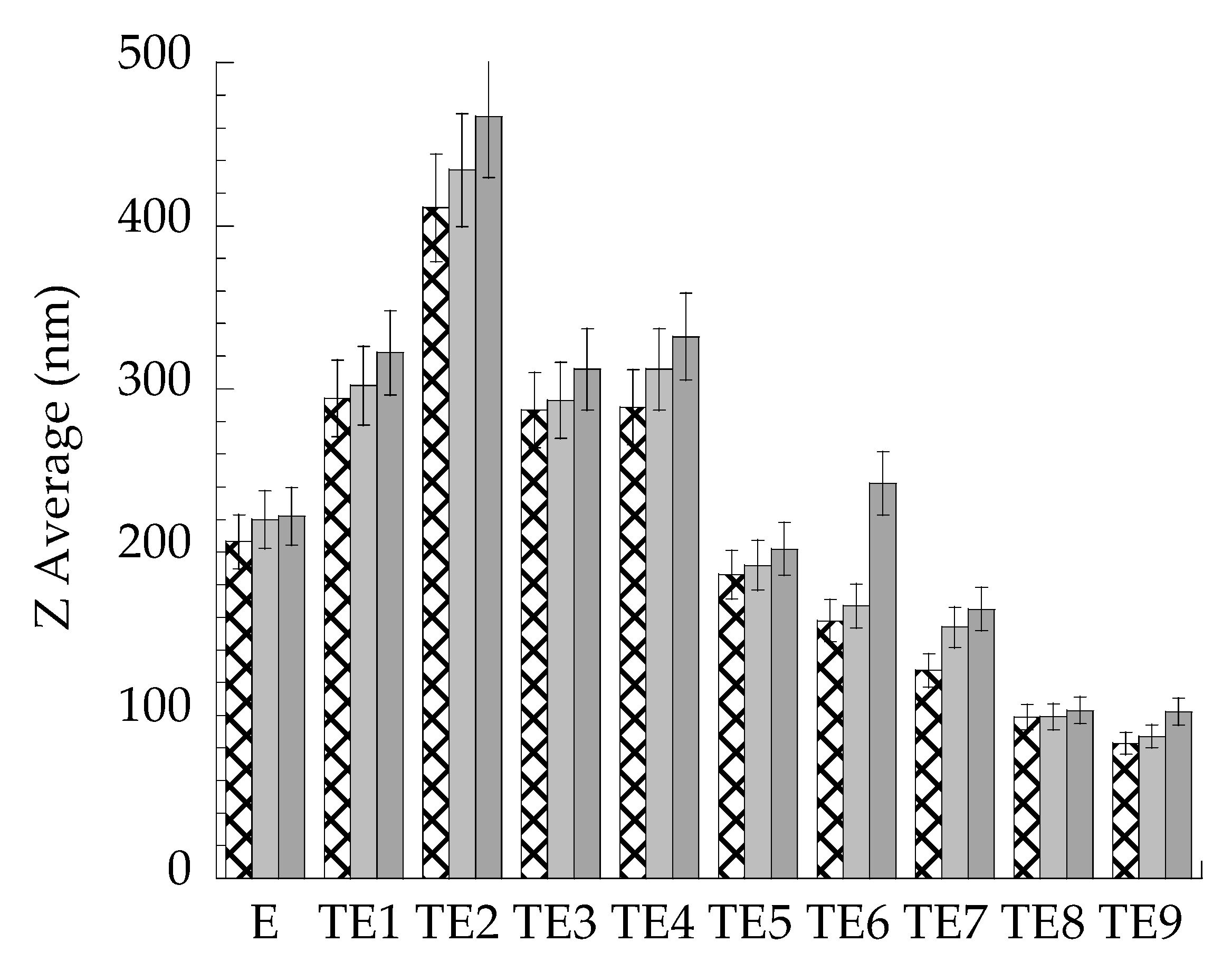
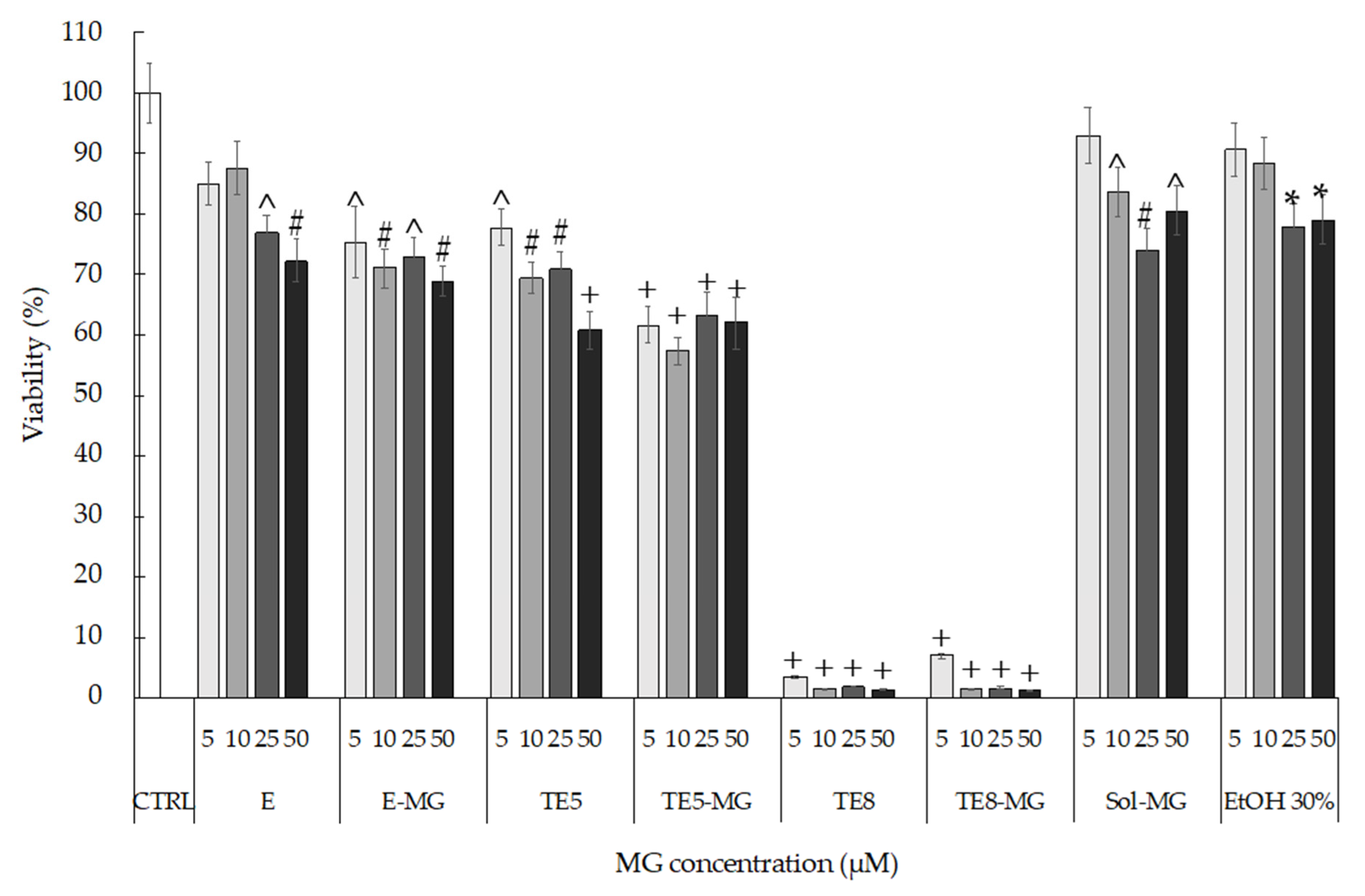

 ), MCE (×), PTFE (o) membranes and ethanol/water 50:50, v/v as receiving phase; (b) ethanol/water 50:50, v/v (
), MCE (×), PTFE (o) membranes and ethanol/water 50:50, v/v as receiving phase; (b) ethanol/water 50:50, v/v ( ), ethanol/water 30:70, v/v (□), water (◊) as receiving phases and nylon as membrane. Data are the mean of 6 independent experiments ± s.d.
), ethanol/water 30:70, v/v (□), water (◊) as receiving phases and nylon as membrane. Data are the mean of 6 independent experiments ± s.d.
 ), MCE (×), PTFE (o) membranes and ethanol/water 50:50, v/v as receiving phase; (b) ethanol/water 50:50, v/v (
), MCE (×), PTFE (o) membranes and ethanol/water 50:50, v/v as receiving phase; (b) ethanol/water 50:50, v/v ( ), ethanol/water 30:70, v/v (□), water (◊) as receiving phases and nylon as membrane. Data are the mean of 6 independent experiments ± s.d.
), ethanol/water 30:70, v/v (□), water (◊) as receiving phases and nylon as membrane. Data are the mean of 6 independent experiments ± s.d.
 ), E-MG (
), E-MG ( ), or TE5-MG (
), or TE5-MG ( ), as determined by the Franz cells assembled with the nylon membrane and ethanol/water 50:50 v/v as receiving phase. Data are the mean of 6 independent experiments ± s.d.
), as determined by the Franz cells assembled with the nylon membrane and ethanol/water 50:50 v/v as receiving phase. Data are the mean of 6 independent experiments ± s.d.
 ), E-MG (
), E-MG ( ), or TE5-MG (
), or TE5-MG ( ), as determined by the Franz cells assembled with the nylon membrane and ethanol/water 50:50 v/v as receiving phase. Data are the mean of 6 independent experiments ± s.d.
), as determined by the Franz cells assembled with the nylon membrane and ethanol/water 50:50 v/v as receiving phase. Data are the mean of 6 independent experiments ± s.d.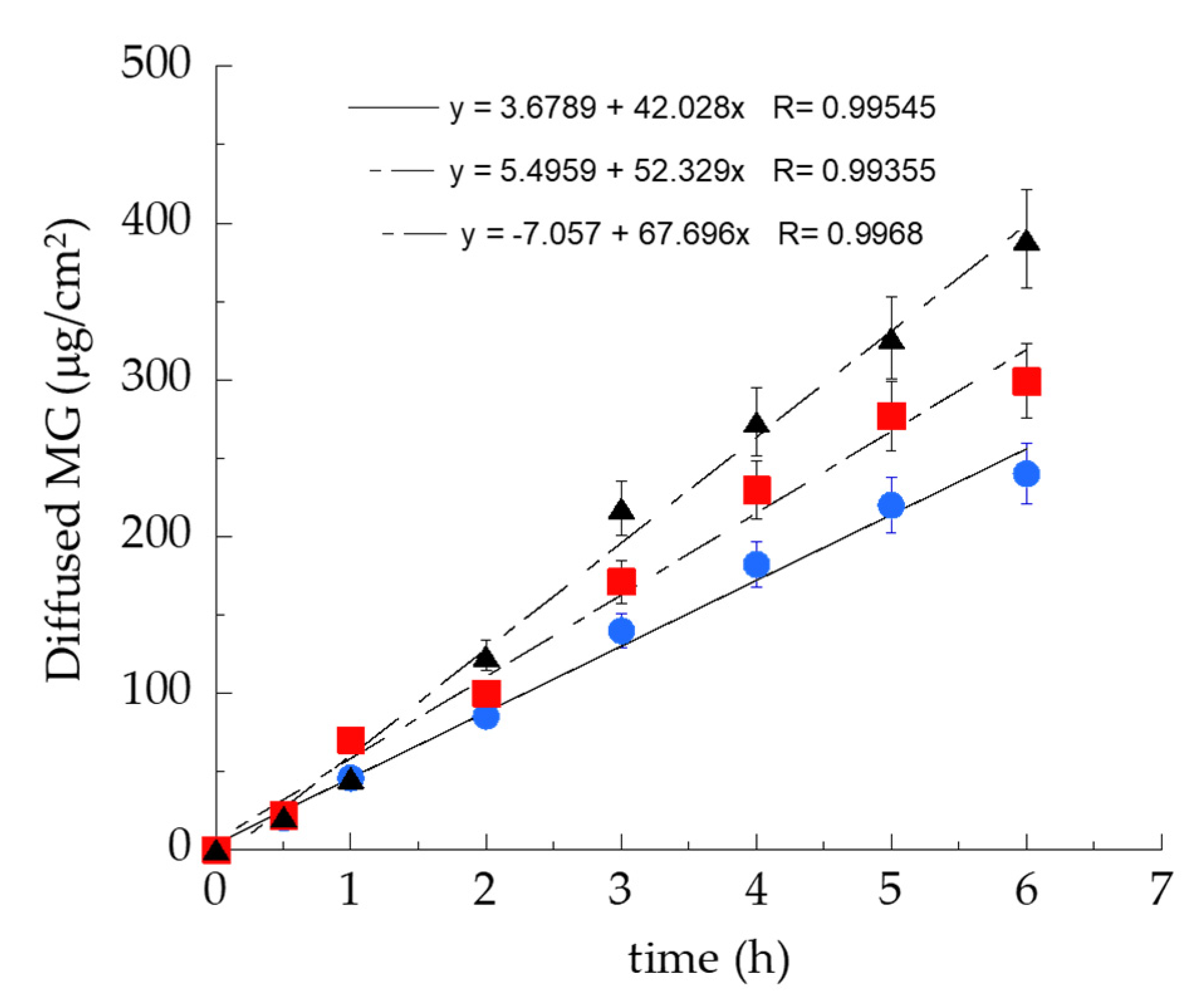
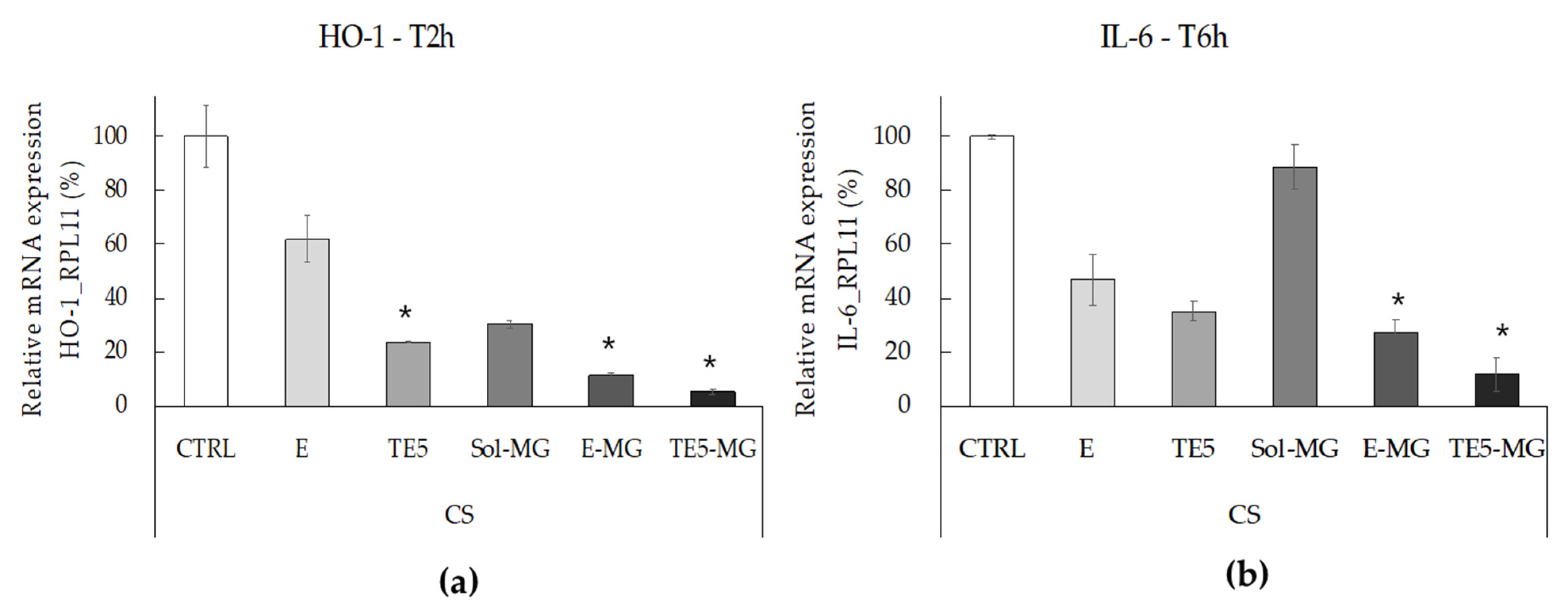

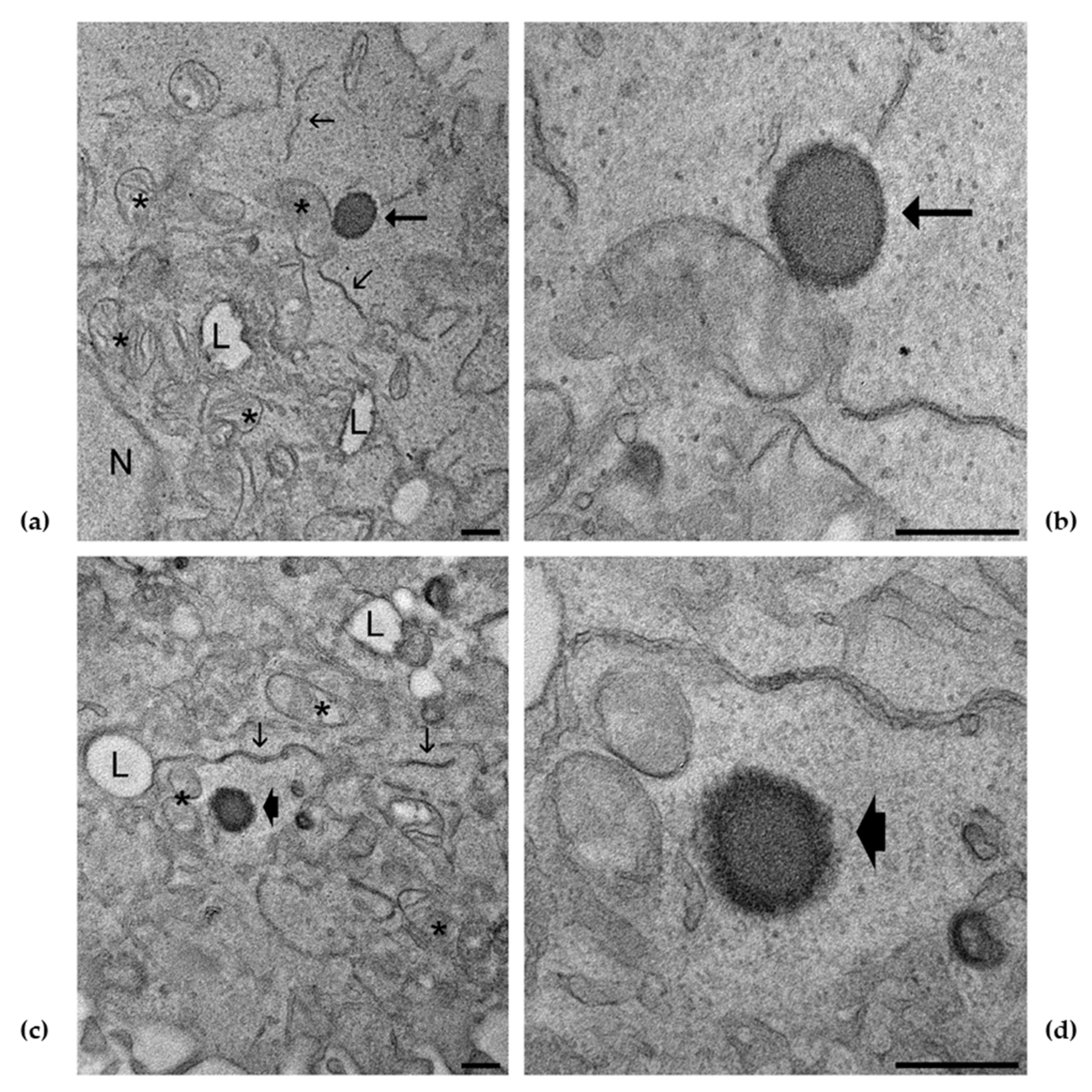
| Solvents | MG Solubility (mg/mL) |
|---|---|
| Water | 0.11 ± 0.01 |
| Ethanol | 0.72 ± 0.01 |
| Methanol | 0.20 ± 0.02 |
| Ethanol/Methanol, 50:50 (v/v) | 0.21 ± 0.00 |
| Dimethyl sulfoxide | 4.00 ± 0.10 |
| Dimethyl sulfoxide/Ethanol, 20:80 (v/v) | 1.00 ± 0.07 |
| Propylene glycol/Water, 60:40 (v/v) | 0.30 ± 0.04 |
| Formulation | PC 1 % w/w | Ethanol % w/w | TW80 2 % w/w | TW20 3 % w/w | SP80 4 % w/w | SP20 5 % w/w | DDAB 6 % w/w | MG 7 % w/w | Water % w/w |
|---|---|---|---|---|---|---|---|---|---|
| E | 0.9 | 29.1 | - | - | - | - | - | - | 70 |
| E-MG | 0.9 | 29.1 | - | - | - | - | - | 0.1 | 69.9 |
| TE1 | 0.89 | 28.81 | - | 0.3 | - | - | - | - | 70 |
| TE2 | 0.89 | 28.81 | - | - | - | 0.3 | - | - | 70 |
| TE3 | 0.89 | 28.81 | - | - | 0.3 | - | - | - | 70 |
| TE4 | 0.89 | 28.96 | 0.15 | - | - | - | - | - | 70 |
| TE5 | 0.89 | 28.81 | 0.3 | - | - | - | - | - | 70 |
| TE6 | 0.89 | 28.51 | 0.6 | - | - | - | - | - | 70 |
| TE7 | 0.9 | 29.1 | - | - | - | - | 0.1 | - | 69.9 |
| TE8 | 0.9 | 29.1 | - | - | - | - | 0.2 | - | 69.8 |
| TE9 | 0.9 | 29.1 | - | - | - | - | 0.3 | - | 69.7 |
| TE5-MG | 0.9 | 29.1 | 0.3 | - | - | - | - | 0.1 | 69.6 |
| TE8-MG | 0.9 | 29.1 | - | - | - | - | 0.2 | 0.1 | 69.7 |
| Formulation | Z-Average (nm) ± s.d. (nm) | Typical Intensity Distribution | Dispersity Index ± s.d. (nm) | Z Potential ± s.d. (nm) | |
|---|---|---|---|---|---|
| nm | Area % | ||||
| E | 206.3 ± 33.13 | 260.7 5065 | 99.5 0.5 | 0.146 ± 0.04 | −23.39 ± 0.2 |
| TE1 | 294.25 ± 2.33 | 318.35 4974 | 99.3 0.7 | 0.120 ± 0.01 | −10.55 ± 0.4 |
| TE2 | 411.1 ± 13.72 | 421.85 4929 | 99 1 | 0.177 ± 0.02 | −13.45 ± 0.2 |
| TE3 | 287.2 ± 9.47 | 288.1 | 100 | 0.052 ± 0.03 | −18.11 ± 0.4 |
| TE4 | 288.8 ± 11.31 | 289.2 | 100 | 0.068 ± 0.01 | −16.90 ± 0.5 |
| TE5 | 186.2 ± 20.29 | 187.0 | 100 | 0.131 ± 0.05 | −33.56 ± 0.3 |
| TE6 | 158.1 ± 2.12 | 159.2 | 100 | 0.122 ± 0.02 | −14.23 ± 0.5 |
| TE7 | 127.45 ± 8.84 | 129.0 | 100 | 0.155 ± 0.04 | 60.53± 0.4 |
| TE8 | 98.82 ± 0.22 | 99.2 | 100 | 0.103 ± 0.02 | 67.35 ± 0.5 |
| TE9 | 82.87 ± 8.89 | 83.2 | 100 | 0.082 ± 0.02 | 71.92 ± 0.6 |
| E-MG | 189.8 ± 13.46 | 178.8 5049 | 99.6 0.4 | 0.134 ± 0.02 | −20.58 ± 0.3 |
| TE5-MG | 169.3 ± 0.46 | 168.7 | 100 | 0.132 ± 0.02 | −28.29 ± 0.4 |
| TE8-MG | 86.41 ± 1.09 | 87.2 | 100 | 0.198 ± 0.01 | 84.08 ± 0.6 |
| Formulation | EC a (%) | DPPH IC50 (µg/mL) | F b (mg/cm2 × h × 103) | D c (cm/h × 103) |
|---|---|---|---|---|
| Sol-MG d | - | - | 67.70 ± 5.51 | 96.71 ± 7.87 |
| E-MG | 68 ± 3 | 20.305 ± 1.89 | 42.03 ± 2.41 | 42.03 ± 2.41 |
| TE 5-MG | 63 ± 2 | 18.407 ± 1.16 | 52.33 ± 3.81 | 52.33 ± 3.81 |
| TE 8-MG | 57 ± 1 | 25.465 ± 0.98 | - | - |
| MG e | - | 17.180 ± 0.53 | - | - |
Publisher’s Note: MDPI stays neutral with regard to jurisdictional claims in published maps and institutional affiliations. |
© 2021 by the authors. Licensee MDPI, Basel, Switzerland. This article is an open access article distributed under the terms and conditions of the Creative Commons Attribution (CC BY) license (https://creativecommons.org/licenses/by/4.0/).
Share and Cite
Sguizzato, M.; Ferrara, F.; Hallan, S.S.; Baldisserotto, A.; Drechsler, M.; Malatesta, M.; Costanzo, M.; Cortesi, R.; Puglia, C.; Valacchi, G.; et al. Ethosomes and Transethosomes for Mangiferin Transdermal Delivery. Antioxidants 2021, 10, 768. https://doi.org/10.3390/antiox10050768
Sguizzato M, Ferrara F, Hallan SS, Baldisserotto A, Drechsler M, Malatesta M, Costanzo M, Cortesi R, Puglia C, Valacchi G, et al. Ethosomes and Transethosomes for Mangiferin Transdermal Delivery. Antioxidants. 2021; 10(5):768. https://doi.org/10.3390/antiox10050768
Chicago/Turabian StyleSguizzato, Maddalena, Francesca Ferrara, Supandeep Singh Hallan, Anna Baldisserotto, Markus Drechsler, Manuela Malatesta, Manuela Costanzo, Rita Cortesi, Carmelo Puglia, Giuseppe Valacchi, and et al. 2021. "Ethosomes and Transethosomes for Mangiferin Transdermal Delivery" Antioxidants 10, no. 5: 768. https://doi.org/10.3390/antiox10050768
APA StyleSguizzato, M., Ferrara, F., Hallan, S. S., Baldisserotto, A., Drechsler, M., Malatesta, M., Costanzo, M., Cortesi, R., Puglia, C., Valacchi, G., & Esposito, E. (2021). Ethosomes and Transethosomes for Mangiferin Transdermal Delivery. Antioxidants, 10(5), 768. https://doi.org/10.3390/antiox10050768














